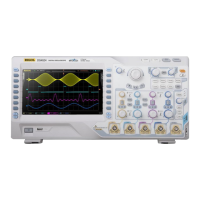Chapter 3 Horizontal System Setting RIGOL
MSO4000/DS4000 User’s Guide 3-7
Application example: measure the phase deviation of the input
signals of two channels.
Method 1: Use Lissajous method
1. Connect a sine signal to CH1 and then connect a sine signal with the same
frequency and amplitude but a 90° phase deviation to CH2.
2. Press AUTO and turn on the X-Y time base mode.
If the XY1 area display is turned on, please move to the next step. If the XY1
area display is turned off, press XY1 to switch to “On”.
3. Use VERTICAL POSITION of CH1 and CH2 to display the signals at the
center of the screen and use VERTICAL
SCALE of CH1 and CH2 to make
the signals easy to observe (if necessary, please refer to “
To Adjust the
Vertical Scale” to switch the vertical scale adjustment mode). At this point, the
circle as shown in the figure below should be displayed.
4. According to the phase deviation measurement principle diagram and the
measurement result in the figure above, it can be calculated that
.
Therefore, the phase deviation angle
.
Note: The maximum sample rate of the oscilloscope in the X-Y mode is 2.0 GSa/s.
Generally, longer sample waveform ensures better figure; but, as being limited by
the memory depth, longer waveform will require a reduction in the sample rate
(please refer to “To Set the Memory Depth”). Therefore, in this measurement
process, reducing the sample rate appropriately can improve the displayed Lissajous
figure.
www.calcert.com sales@calcert.com1.800.544.2843
0
5
10
15
20
25
30

